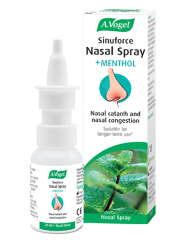How does a blocked nose develop?
Mucus is our body’s natural defence mechanism against viruses as it traps these things and then removes them from the body. However, problems arise when mucus solidifies and is unable to flow freely from the mucous membranes in the respiratory tract.
Congestion has many unpleasant side effects such as headaches, sinus pain and loss of taste and smell. Therefore, although it can be messy, allowing the mucus to break up and move more freely is beneficial. Better out than in is definitely the case here!
So, how can you get rid of the runny stuff? Well, a few dietary adjustments and herbal products is definitely the place to start!

Cut down on dairy
This may not seem the most obvious way to tackle a blocked nose but cutting down your intake of dairy could help to reduce the production of mucus and in doing so will ease that stuffy feeling.
Many everyday ingredients such as milk, cheese, yogurt, butter, cream and some varieties of margarine all contain dairy so it can seem a little daunting to cut these things out your diet. However, most health food stores and even supermarkets contain tasty alternatives such as almond milk, coconut butter and dairy-free yogurt.

Reduce your intake of refined sugar
Refined sugar gives the pancreas a great deal of work to do and as a result it can lead to a heavier load for the mucous membranes. So, reduce the amount of refined sugar in your diet (this includes concentrated fruit juice, sports drinks, cakes) and replace it with the likes of dried fruit and fruit bars.
Consume more vitamin C

Vitamin C strengthens the mucous membranes and is particularly good for the lining of the respiratory tract. Not only that though, vitamin C is also highly beneficial for the immune system so if you are suffering from other symptoms of a cold or flu this could help you get over them more quickly!
Citrus fruits like lemons and oranges are the most obvious choices if you are looking to consume more vitamin C but don’t forget that tomatoes, strawberries and even red bell peppers all have high quantities too.
If you feel you need an extra vitamin C boost however, you could also turn to our Nature-C Tablets. These are rich in naturally occurring vitamin C as they are made from a wide variety of fruits such as blackcurrants, lemons and passion fruit.
A.Vogel Chewable Nature-C vitamin C tablets for Immune Support*, from natural fruit sources, 36 tablets
£9.99 (36 tablets) In Stock Get it tomorrow, 16th April.
Try more zinc
 Zinc is good for your lungs and your immune system, plus it can help to restore taste and smell. It’s found in pumpkin and sunflower seeds but taking a supplement for a short period isn’t a bad idea either.
Zinc is good for your lungs and your immune system, plus it can help to restore taste and smell. It’s found in pumpkin and sunflower seeds but taking a supplement for a short period isn’t a bad idea either.
Our Balance Mineral Drink is a great option here because not only does it contain zinc, it contains a host of other minerals and vitamins too. This includes magnesium, calcium, potassium and vitamin D which together should help you quickly recover from cold and flu symptoms.
Plantago could help
This is a friend to the mucous membranes lining the ear, nose and throat tract (ENT tract)! That’s because it has an astringent action that helps to clear the mucus lying there, plus it tones up the tissue that often become inflamed and irritated there. This makes it an excellent choice for mopping up the mucus misery after the actual cold has departed.

Try a little Po Ho oil
This is a great natural option if you need to clear the nose. Simply put a few drops in a bowl of warm water and inhale deeply. Alternatively, put a few drops on a scrunched up tissue, hold it to your nose and then inhale.
Don’t forget about Echinacea
Interestingly, it has recently been found that Echinacea, that stalwart of the cold and flu season, reverses the production of mucus during infection with a rhinovirus (a bug that causes a cold).
There are special cells called goblet cells in the respiratory tract, and they secrete mucus when the cold virus hits. Obviously you need some of this slime to help trap and remove the bug, but taking Echinacea can help keep the mucus production within reasonable limits.
Orignally published 12 September 2013 (updated on 22 Ocotober 2018).





-new-web-carton.png?m=1710946347)




